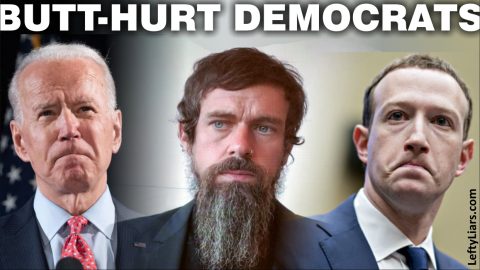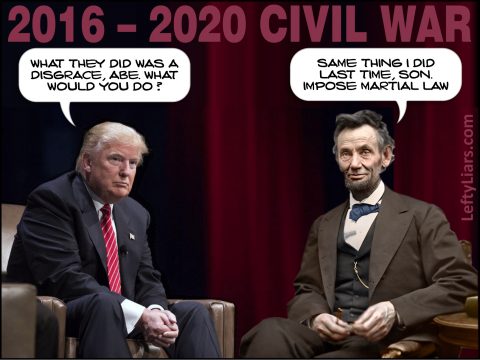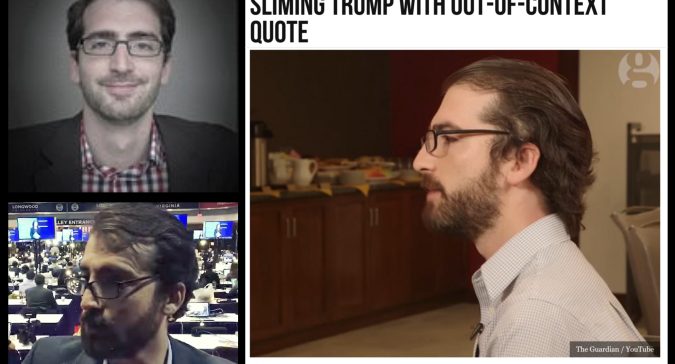
When Fake News reports on Trump, they throw out all the customary journalism rules and bend convention out of shape. Standard protocols no longer apply. Take two areas, for example, celebrity aliases and prank phone calls. Journalists have dealt with both for centuries and are experts in the traditional way to approach each. In this article, I will show how they ignored the rules regarding each, in a shameful attempt to discredit Donald Trump.
What’s more, they did this without even covering their tracks. The anti-Trump media took a few bits of information about their target’s aliases and made a childish mash-up with them before launching a simultaneous multi-pronged attack, as is their SOP. It was an attempt to persuade the public that Trump was crazy about making weird phone calls and begging for publicity. It was another nothingburger.
Celebrity Aliases
One of the first things journalists learn is that stars, billionaires, and politicians often have to use pseudonyms or aliases as there is no choice. Without them, the VIP (Very Important Person) might be attacked, assaulted, abused, kidnapped, or murdered. The whole point of a pseudonym is that you don’t reveal it to anyone, not just to protect the VIP, but their partners, children, and staff. All are at risk should the VIP’s identity be exposed. Using an alias for booking hotels or restaurants prevents the media from finding out. Most journalists are taught to respect aliases, and reporting them is frowned upon as it could risk lives. Nonetheless, some gutter-press reporters publish or broadcast such information, so it pays to be cautious.
When a VIP denies having an alias, it is not technically lying because safety and force are involved. When it comes to saving your children, denying an alias is described as security. We don’t call the President a liar when he says, “No, I’m not booked in at the Hilton as ‘Mr. Smith.’ We call it ‘national security.’ Most (if not all) Hollywood stars use aliases, and half the celebrity talking heads in Fake News do, also. Journalists know all this. The famous ones use pseudonyms themselves. Don Lemon probably uses the name “Lon Demon” as a joke. If so, it would be a good choice.
Another reason rich businessmen use aliases is that when they buy property, the seller will often raise the price upon knowing the caller is rich. If John D. Rockefeller or Howard Hughes rang someone about purchasing a ten million dollar building, the seller would suddenly be asking for twenty million upon learning the richest man in the world was on the other end of the line. The billionaire could save ten million just by saying, “Hi, I’m John Smith,” instead of revealing his true name. Who, among you, would use your correct name under those circumstances? You may cast the first stone.
Prank Phone Calls
Every Newspaper and TV network has pranksters calling, pretending to be VIPs. Fanatical fans, jokers, political trolls, obsessed fans, or mentally unstable loons will pretend to be everyone from the Queen to the Boston Strangler. Police have a difficult time with fake criminals confessing to significant crimes. There are thousands of pranksters in every city, and any two-bit TV manager or newspaper editor knows about them.
Even suburban phone users know about them. The first thing to decide when receiving a prank call is whether they sound like the VIP in question. Most do not. Then there is the content of their words. If a prankster could talk like Adele but said, “I am going to kill your family,” you could safely assume it was not Adele. Journalists are taught all about this. They are cautioned to be wary of all unbelievable tales, especially over the phone. It is essential to verify the caller’s identity with a name and address and have some way to authenticate them as a legitimate source.
When Donald Trump announced he was running for office Fake News abandoned all protocol concerning celebrity aliases and prank calls, for him. Let’s take a look at just one of these multi-pronged attacks by Fake News, and undo their Lefty Lies.
People Magazine
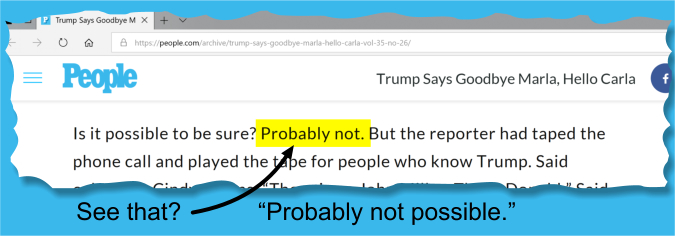
We start with the gossip rag People Magazine, which must have been desperate in 1991 when they published a story about their anonymous reporter receiving a call from a “John Miller” who claimed to be “handling Donald Trump’s publicity.” An “anonymous source” recorded the call. According to the 1991 article (backup here), it was “probably not” Trump.
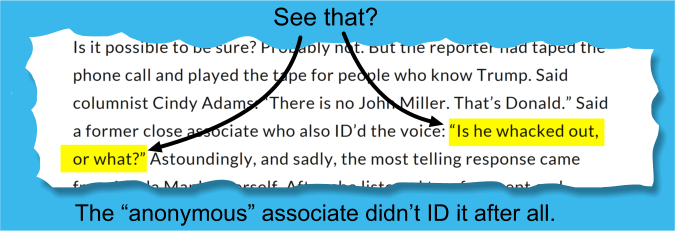
Even though they said it was probably not Trump, People Magazine went on to say that their anonymous source said another unnamed source “ID’d the voice,” but the anonymous source forgot to say WHOM her unknown source identified the voice as.
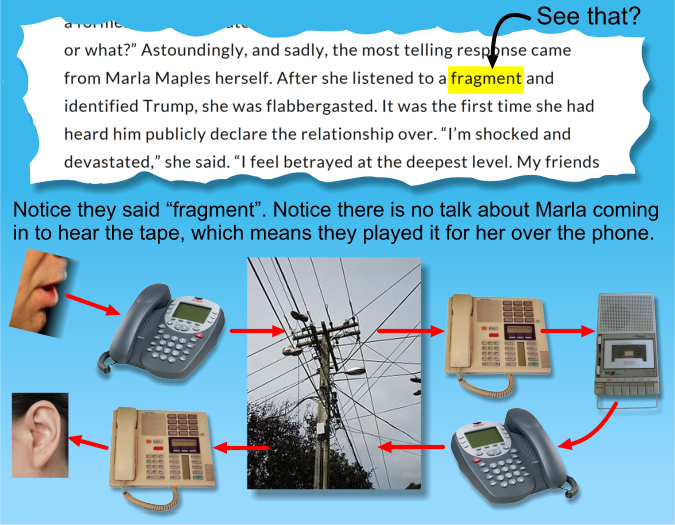
Fragment? That smells fishy. I can imagine Marla saying, “No, it doesn’t sound like him, except for a small bit,” so they come up with the word ‘fragment.’ Also, they played the tape over the phone to Marla, who just took their word when they told her they thought it was Trump. In reality, the recording sounds nothing like Trump, but they would have told her it was scrambled and re-hashed eight times between the spoken words and her ear to explain its poor quality.
I would guess that no anonymous reporter received the call, and no anonymous friend commented on it. Sue Carswell wrote the story. That’s one person. I think she broke all the journalistic ethics by accepting a prank call and publishing a story about it. It was typical gutter reporting and took less time to write than the article I’m writing about it. Let’s hear the recording:
This particular prank caller has a New York accent and is hamming it up as Donald Trump, and some would say he’s doing a good job. To them, all New York businessmen sound like this. A prankster conned Sue Carswell. She ignored the usual rules regarding hoaxes and took it seriously, without verifying the caller’s identity. Journalists should never sit around gossiping about what they think of a bad recording – some pranksters are brilliant and can fool reporters easily. Instead, they should ask a bunch of questions, verify the person’s background, check-up on them, call them back at a number they trust, and decide that way.
Sifting Through the Past
Twenty-five years later, Trump was heading into an election and was looking like he might win. A quarter of a century later and Fake News went on the alert! The order was sent out. Find anything you can use against Donald Trump. Any bit of gossip will do. The desperadoes dug this inane People Magazine article up and decided to create a giant nothingburger with it.
Nineteen days before the election, Frontline PBS came out with this lame story, 20 Oct 2016. They rave about the People Magazine article with sinister tones and a deep-voiced commentator, as though it was some Watergate event. How pathetic is that? With a stern, deep voice, the commentator grimly says, “Trump did a phone interview with People Magazine under the name John Miller.”
So all of a sudden it is a fact! It went from “probably not Trump” from People Magazine to “It was Donald Trump pretending to be John Miller,” courtesy of Frontline PBS. Trump, who said many times that it was not him, was tried and found guilty by Fake News. They now broadcast it as a fact, without any evidence. After the Ford/Kavanaugh scandal, we now know that Fake News and the Democrats don’t believe you need proof to find someone guilty. You go right on ahead and find them guilty if someone accuses them. There’s no need for the presumption of innocence.
On 25 May 2016, sneering Jimmy Kimmel interviewed Trump, bringing up the nothingburger about John Miller. This clip shows that part of the interview:
The entire interview, which has been deleted by most of Fake News, may be seen here, at archive.org. Regarding John Miller, the transcript went as follows [emphasis mine]:
Kimmel: That call with the People Magazine reporter – that guy who sounded like you calling and going, “Yeah, and then Trump did this…”
Trump: It didn’t sound like me, though, really. You think that sounded like me?
Kimmel: Yeah…
Trump: I don’t.
Kimmel: You know how people hear their voice, and they don’t think their voice sounds like their voice…
Trump: But it didn’t sound like it – you know it was twenty-eight, and by the way, the reporter came back and said, “I think Trump gave out the tape,” give me a break, from twenty-eight years ago
Kimmel: Yeah, why would you give out that tape?
Trump: I think they felt that it wasn’t my voice, and they didn’t want to have the liability, but you know, honestly, I discussed this the other night on Sean Hannity’s show, and it was really a very good discussion, and check it out. But I will say this; to me, that didn’t sound like my voice.
Kimmel: It di – well, nobody sounds like themselves when they hear themselves. You go, “Oh, that’s me…”
Trump: Maybe, maybe…
Kimmel: But to me, it sounded just like you.
Trump: Really? Is that right?
Kimmel: Yeah. It did
Trump: Thirty years? Thirty…
Kimmel: And if it was you, I think it was a very funny thing to do. To call a guy and take him through the wringer like that.
Trump: Well, you know over the years I’ve used aliases, and when I’m in real estate and, especially when I was out in Brooklyn with my father and I’d want to buy something, and honestly, nobody knew who Trump was at that time, nobody knew me, so it wasn’t so much so important, but I would never want to use my name because you had to pay more money for the land. If you’re trying to buy land, you use different names, and you have an alias.
Kimmel: What names do you use?
Trump: I would use – I actually used the name Barron, and I ended up using my son because I made a very good deal using that name. I used an alias in terms of setting up a meeting with Mr. Donald Trump. And it was – and many people in the real estate business do that. You use aliases, and you have to, frankly; otherwise, they find out it’s you, and they charge you more money, and nobody wants to pay more money.
CNN published a hacked-up video of the above, with chunks missing, to make Trump look like a liar. I had an embedded copy here, using the following coding:
<iframe src=”//fave.api.cnn.io/v1/fav/?video=politics/2016/05/26/donald-trump-jimmy-kimmel-alias-jnd-orig-vstop.cnn&customer=cnn&edition=international&env=prod” frameborder=”0″></iframe>
Fake News cut out various sentences of Trump’s if they sounded reasonable. For example, CNN deleted the last 73 words (in blue) from the video. After the word ‘Barron,’ they ended the tape and put up the statement, “BARRON IS THE NAME OF HIS NOW 10-YEAR-OLD SON,” as though that was a terrible thing. They censored the part about using the name to set up meetings with Donald Trump. They censored the part about how real estate agents had to use aliases or pay more. It helped CNN sell the idea that Trump used aliases for devious reasons and was trying to deny it.
*The video disappeared soon after I put it on this page and exposed their mischievous editing. I cannot find it anywhere on CNN’s server or the internet.
Other Fake News outlets like the Guardian showed bits of the interview. That Guardian article is one of the thousands that tried to make a mountain out of the John Williams molehill. It was written by Ben Jacobs, whose sneering headline reads:
Trump confesses he used the name Barron
Trump said he used the name Barron. Confession insinuates he committed a crime. Wow – the Fake News is strong in this Ben Jacobs. So who is this knucklehead, anyway?
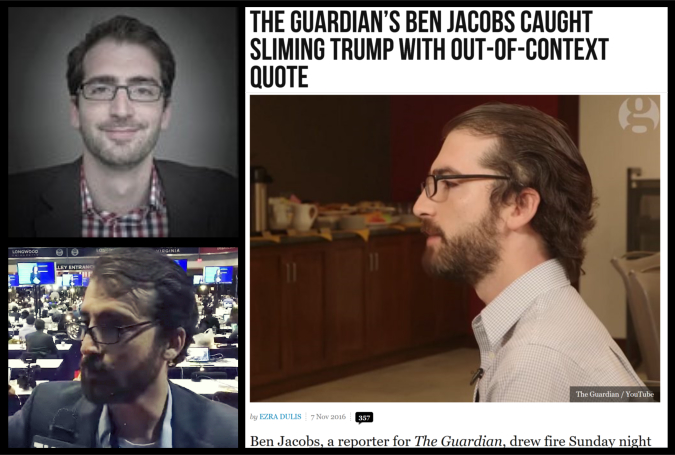
That would be 35-year old Trump-hating North Dakotan millennial snowflake Ben Jacobs. During college in Iowa, he was president of the College Democrats, then a freelance reporter for The Daily Beast before working for The Guardian. He is based in Washington, D.C. Here’s an article about his “sliming” Trump with a misquote.



